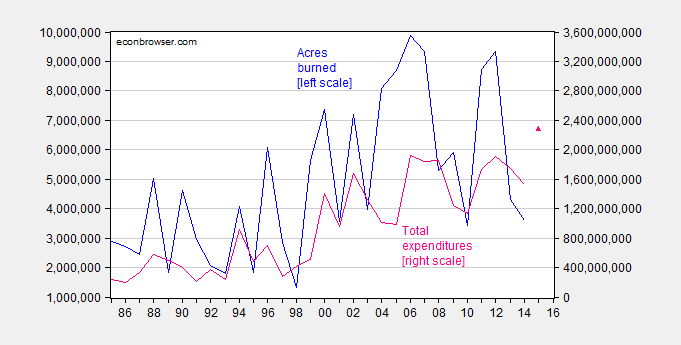Acres burned already exceeds the comparable figure for 2006, the previous record year.

Figure 1: Acres burned to August 22 (blue bar), from August 22 to September 25 (red bar) and to year-end (green bar). Source: NIFC1, NFIC2, author’s calculations.
Using the same regression (log acres on log acres ytd) used in this post, my estimate of acres burned has risen from 9.62 million to 9.76 million.
This in turn raises the estimated total expenditures from $2.27 billion to $2.29 billion.
Figure 2: Acres burned (blue, left scale) and total Federal firefighting expenditure in dollars (pink, right scale) predicted 2015 (pink triangle). Source: NIFC1, NFIC2, and author’s calculations.
I’ve only tabulated direct Federal fiscal costs; here is an article on part of the human toll. Further note that these costs do not include state level costs. Cal Fire’s total budget for the current fiscal year is about $390 million.[1]

I’m sure this is directly related to global warming because #models
Rather than a test of the broken-window fallacy, it will be a test of the overpopulated, dry, burned-and-blackened-landscape fallacy.
Social mania and biobubbletech stocks are setting up for a Dotcom-like crash, whereas CA unreal estate is in another bubble that peaked in 2013-14 and has begun to deflate in some areas. High-end, buy-up housing is likely to be hit harder this time around. The historical precedent is for another 30-40% real price decline in the next 4-6 years. With CPI decelerating and with the potential for deflation, the nominal price decline could be larger this time.
The combination of equity and unreal estate busts, mega-drought, and wildfire damage will significantly reduce uneconomic activity in CA for years to come. The incipient bust in the energy sector will similarly damage TX’s economy. Another stock and unreal estate bear market will hit the financial sector. The energy and energy-related transport sectors’ busts will continue to be a drag on IP. Decelerating growth of global real GDP per capita and the end of growth of “trade” will weigh on commodities prices.
So, CA (Left Coast), TX, the NE, and the industrial heartland are in for another Great Recession-like episode, only this time probably with ZIRP, no multiplier from $1 trillion deficits and fiscal “stimulus” (bailouts, foodstamps, unemployment payments, Medicaid, covering the shortfall for SS, Medicare, etc.), and periodic price deflation, including services prices falling.
Not sure why no fires are indicated here: http://activefiremaps.fs.fed.us/data/lg_fire/lg_fire_nifc_2015-09-30_browse.png
And now the forest service wants to start fires. http://www.fs.usda.gov/detail/prescott/alerts-notices/?cid=fswdev3_009865
Apparently, decades of suppressing fires has had unintended consequences.
Suppressing fires is credited in large part for the pine beetle epidemic that has swept through British Columbia and other parts of western North America.
Pasted from the National Geographic:
For its current good fortune, the mountain pine beetle can thank us. To start with, we’ve spent the past century eliminating forest fires—thereby turning the woods into beetle buffets. When the crisis began, British Columbia’s forests were packed with three times as many mature pines as there would have been had they been allowed to burn naturally. Like mountain pine beetles, fire is native to western forests, and it’s as important as rain to their health. It nourishes soil, spreads seeds, creates openings for sunlight, ensures habitat for all sorts of creatures.
http://ngm.nationalgeographic.com/2015/04/pine-beetles/rosner-text
If you read the rest of the Nat Geo text you will find this:
“That vulnerability intensified the epidemic—but a change in climate was required to kick it off. The beetle has us to thank too for warming the whole planet with our carbon dioxide emissions.”
So easy to overlook. I know.
Just blame it on fire control, which is an issue, for sure.
But pine bark beetles need slightly warmer temperatures to spread north, which we have provided them.
Sometimes it pays to read the whole article.
I read the entire article. Prior to the hysteria surrounding the climate change issue, temperature regimes had already been fluctuating over the decades.
Moreover, let’s assume that anthropogenic climate change is the fundamental driver behind the explosion in pine beetle numbers. Those managing the forests should take climate change as an exogenous factor and deal with it; not finger point something they have no direct control over.
Just like salmon returns. Pre-contact and early contact, west coast natives occasionally starved due to a lack of food (returning salmon).
A few years ago, BC was selling blue-stained pine beetle infected pine as fast as possible into the then buoyant US market. Stumpage fees were reduced to a fraction of regular fees.
Naturally US-based softwood producers considered this unfair trade — and it was. For BC politicians it was yet another chance to provide lots of well paid jobs to semi-skilled workers. Presumably, a vote-maximizing politician will not target executive or professional positions but rather more numerous unskilled and semi-skilled positions.
Once again, that boom turned to a bust picked up by the welfare state. Explosions and fires occurred in a number of mills, often with deadly consequences. Most appeared to be obsolete, undercapitalized or simply poorly maintained. Mill owners seemed to know that the boom would not last.
As BCers appear incapable of erecting sufficient barriers to entry for crown-owned resources, thus avoiding excess entry— the tragedy of the insufficiently managed commons writ large–it occurred to me that burning down over half of the province’s softwood lumber supply would ‘solve’ this problem and put the sector back on track for sustainable resource rent maximization.